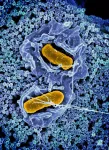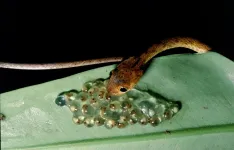NIH scientists find that salmonella use intestinal epithelial cells to colonize the gut
2021-05-26
(Press-News.org) WHAT:
The immune system's attempt to eliminate Salmonella bacteria from the gastrointestinal (GI) tract instead facilitates colonization of the intestinal tract and fecal shedding, according to National Institutes of Health scientists. The study, published in Cell Host & Microbe, was conducted by National Institute of Allergy and Infectious Diseases (NIAID) scientists at Rocky Mountain Laboratories in Hamilton, Montana.
Salmonella Typhimurium bacteria (hereafter Salmonella) live in the gut and often cause gastroenteritis in people. The Centers for Disease Control and Prevention estimates Salmonella bacteria cause about 1.35 million infections, 26,500 hospitalizations and 420 deaths in the United States every year. Contaminated food is the source for most of these illnesses. Most people who get ill from Salmonella have diarrhea, fever and stomach cramps but recover without specific treatment. Antibiotics typically are used only to treat people who have severe illness or who are at risk for it.
Salmonella bacteria also can infect a wide variety of animals, including cattle, pigs and chickens. Although clinical disease usually resolves within a few days, the bacteria can persist in the GI tract for much longer. Fecal shedding of the bacteria facilitates transmission to new hosts, especially by so-called "super shedders" that release high numbers of bacteria in their feces.
NIAID scientists are studying how Salmonella bacteria establish and maintain a foothold in the GI tract of mammals. One of the first lines of defense in the GI tract is the physical barrier provided by a single layer of intestinal epithelial cells. These specialized cells absorb nutrients and are a critical barrier that prevent pathogens from spreading to deeper tissues. When bacteria invade these cells, the cells are ejected into the gut lumen--the hollow portion of the intestines. However, in previous studies, NIAID scientists had observed that some Salmonella replicate rapidly in the cytosol--the fluid portion--of intestinal epithelial cells. That prompted them to ask: does ejecting the infected cell amplify rather than eliminate the bacteria?
To address this question, the scientists genetically engineered Salmonella bacteria that self-destruct when exposed to the cytosol of epithelial cells but grow normally in other environments, including the lumen of the intestine. Then they infected laboratory mice with the self-destructing Salmonella bacteria and found that replication in the cytosol of mouse intestinal epithelial cells is important for colonization of the GI tract and fuels fecal shedding. The scientists hypothesize that, by hijacking the epithelial cell response, Salmonella amplify their ability to invade neighboring cells and seed the intestine for fecal shedding.
The researchers say this is an example of how the pressure exerted by the host immune response can drive the evolution of a pathogen, and vice versa. The new insights offer new avenues for developing novel interventions to reduce the burden of this important pathogen.
INFORMATION:
ARTICLE:
A Chong et al. Cytosolic replication in epithelial cells fuels intestinal expansion and chronic fecal shedding of Salmonella Typhimurium. Cell Host & Microbe DOI: 10.1016/j.chom.2021.04.017 (2021).
WHO:
Olivia Steele-Mortimer, Ph.D., chief of NIAID's Salmonella-Host Cell Interactions Section, and Audrey Chong, Ph.D., in the Salmonella-Host Cell Interactions Section, are available to comment.
CONTACT:
To schedule interviews, please contact the NIAID Office of Communications, (301) 402-1663, niaidnews@niaid.nih.gov.
INFORMATION:
NIAID conducts and supports research--at NIH, throughout the United States, and worldwide--to study the causes of infectious and immune-mediated diseases, and to develop better means of preventing, diagnosing and treating these illnesses. News releases, fact sheets and other NIAID-related materials are available on the NIAID website.
About the National Institutes of Health (NIH): NIH, the nation's medical research agency, includes 27 Institutes and Centers and is a component of the U.S. Department of Health and Human Services. NIH is the primary federal agency conducting and supporting basic, clinical, and translational medical research, and is investigating the causes, treatments, and cures for both common and rare diseases. For more information about NIH and its programs, visit http://www.nih.gov/.
NIH...Turning Discovery Into Health®
[Attachments] See images for this press release:

ELSE PRESS RELEASES FROM THIS DATE:
2021-05-26
The COVID-19 pandemic has seen scientists perform incredible feats in a short amount of time, from developing tests to new types of vaccines. Despite these victories, experts are still working to develop an effective antiviral drug to kill the SARS-CoV-2 virus. A cover story in Chemical & Engineering News, the weekly newsmagazine of the American Chemical Society, details the challenges of and progress toward creating a drug that would help the world conquer COVID-19.
Creating a new antiviral drug is a tricky business. Viruses mutate and replicate quickly, and their structures differ greatly even within the same class, ...
2021-05-26
American writer and humorist Mark Twain, a master of language and noted lecturer, once offered, "The right word may be effective, but no word was ever as effective as a rightly timed pause."
Electric fish and today's TED talk speakers take a page from Twain's playbook. They pause before sharing something particularly meaningful. Pauses also prime the sensory systems to receive new and important information, according to research from Washington University in St. Louis.
"There is an increased response in listeners to words -- or in this case, electrical pulses ...
2021-05-26
It's well known that reptiles depend on temperature cues while in the egg to determine a hatchling's sex. Now, researchers writing in the journal Trends in Ecology & Evolution on May 26 say that embryos of many different animal species also rely on acoustic signals in important ways. They call this phenomenon "acoustic developmental programming."
"Acoustic developmental programming occurs when a sound informs embryos about the environment they'll encounter postnatally and changes their development to better suit this environment," said Mylene Mariette (@MyleneMariette) of Deakin University in Australia.
Because this is a newly discovered phenomenon, the evidence is just beginning to accumulate. And, yet, it seems to ...
2021-05-26
Skokie, IL - The International Society for Stem Cell Research (ISSCR), today released updated guidelines for stem cell research and its translation to medicine. The update reflects emerging advances including, stem cell-based embryo models, human embryo research, chimeras, organoids, and genome editing.
"The 2021 update presents practical advice for oversight of research posing unique scientific and ethical issues for researchers and the public," said Robin Lovell-Badge, PhD, FRS, Chair, ISSCR Guidelines task force and Senior Group Leader and Head of the Division of Stem Cell Biology and Developmental Genetics at The Francis Crick Institute, UK. "They provide confidence to researchers, clinicians, and the public ...
2021-05-26
The multifunctional porous solids with diverse functionalized linkers have been utilized as promising materials for various applications in energy, environmental and biomedical areas. Although their emerging properties are ascribed to varying pore types resulting from combinations of functional groups, the chemical environment of the pores remains an open question. A new synthetic platform where the population of pores can be identified and further controlled is of great interest in materials science.
A research team, led by Professor Wonyoung Choe and Professor Tae-Hyuk Kwon in Department of Chemistry ...
2021-05-26
Communities benefit from sharing knowledge and experience among their members. Following a similar principle - called "swarm learning" - an international research team has trained artificial intelligence algorithms to detect blood cancer, lung diseases and COVID-19 in data stored in a decentralized fashion. This approach has advantage over conventional methods since it inherently provides privacy preservation technologies, which facilitates cross-site analysis of scientific data. Swarm learning could thus significantly promote and accelerate collaboration and information exchange in research, especially in the field of medicine. Experts from the DZNE, the University of Bonn, the information technology company Hewlett Packard Enterprise (HPE) and other research institutions report on ...
2021-05-26
New research published in Nature provides a powerful yet surprisingly simple way to determine the number of visitors to any location in a city.
Scientists* from the Santa Fe Institute, MIT, and ETH Zürich have discovered and developed a scaling law that governs the number of visitors to any location based on how far they are traveling and how often they are visiting. The visitation law opens up unprecedented possibilities for accurately predicting flows between locations, which could ultimately have applications in everything from city planning to preventing the spread of the next major pandemic.
"Imagine you are standing on a busy plaza, say in Boston, and you see people coming and going. This ...
2021-05-26
What The Study Did: This study included data from more than 11,000 emergency medical services (EMS) agencies in 49 states to describe racial/ethnic, social and geographic changes in EMS-observed overdose-associated cardiac arrests during the COVID-19 pandemic through 2020 in the United States.
Authors: Joseph Friedman, M.P.H., of the University of California, Los Angeles, is the corresponding author.
To access the embargoed study: Visit our For The Media website at this link https://media.jamanetwork.com/
(10.1001/jamapsychiatry.2021.0967)
Editor's Note: The article includes funding/support disclosures. Please see the article for additional information, including other authors, author ...
2021-05-26
What The Study Did: Researchers conducted a review of studies examining the frequency and variety of persistent symptoms after COVID-19 infection.
Authors: Steven N. Goodman, M.D., M.H.S., Ph.D., of Stanford University in Stanford, California, is the corresponding author.
To access the embargoed study: Visit our For The Media website at this link https://media.jamanetwork.com/
(doi:10.1001/jamanetworkopen.2021.11417)
Editor's Note: Please see the article for additional information, including other authors, author contributions and affiliations, conflict of interest and financial disclosures, and funding and support.
INFORMATION:
Media ...
2021-05-26
What explains how often people travel to a particular place? Your intuition might suggest that distance is a key factor, but empirical evidence can help urban studies researchers answer the question more definitively.
A new paper by an MIT team, drawing on global data, finds that people visit places more frequently when they have to travel shorter distances to get there.
"What we have found is that there is a very clear inverse relationship between how far you go and how frequently you go there," says Paolo Santi, a research scientist at the Senseable City Lab at MIT and a co-author of the new paper. "You only seldom go to faraway places, and usually you tend to visit places close to you more often. It tells us how we organize our lives."
By examining cellphone data ...
LAST 30 PRESS RELEASES:
[Press-News.org] NIH scientists find that salmonella use intestinal epithelial cells to colonize the gut



